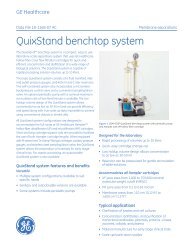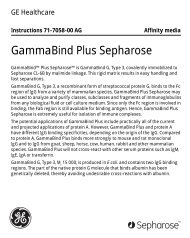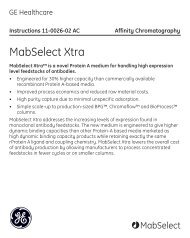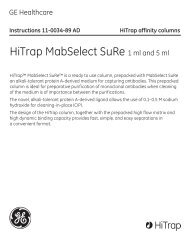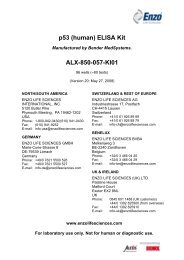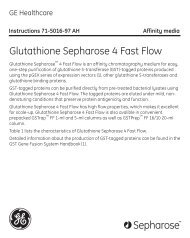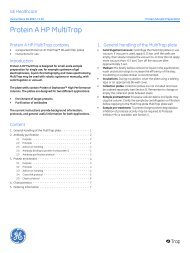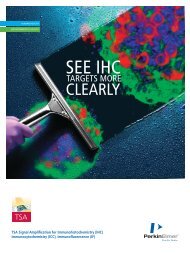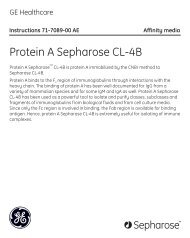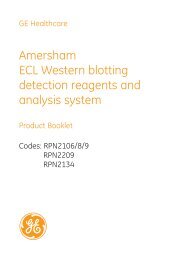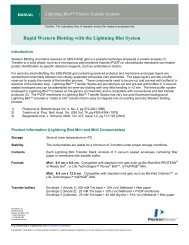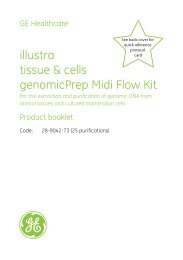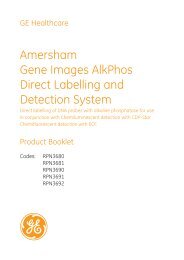You also want an ePaper? Increase the reach of your titles
YUMPU automatically turns print PDFs into web optimized ePapers that Google loves.
<strong>GammaBind</strong> G <strong>Sepharose</strong>INSTRUCTIONS<strong>GammaBind</strong> G <strong>Sepharose</strong> is <strong>GammaBind</strong> G, Type 2, covalentlyimmobilized to <strong>Sepharose</strong> 4B by the cyanogen bromide method.<strong>GammaBind</strong> G, Type 2, a recombinant form of streptococcalProtein G, binds to the F c region of IgG from a variety ofmammalian species.<strong>GammaBind</strong> G <strong>Sepharose</strong> may be used to analyze and purifyclasses, subclasses and fragments of immunoglobulins from anybiological fluid or cell culture medium. Since only the F c region isinvolved in binding, the F ab region is still available for bindingantigen. Hence, <strong>GammaBind</strong> G <strong>Sepharose</strong> is extremely useful forisolation of immune complexes.The potential applications of <strong>GammaBind</strong> G <strong>Sepharose</strong> includepractically all of the current and projected applications of Protein A<strong>Sepharose</strong>. However, <strong>GammaBind</strong> G and Protein A have differentIgG binding specificities, depending on the origin of the IgG, seeTable 2. Compared to Protein A, <strong>GammaBind</strong> G binds morestrongly to mouse and rat monoclonal IgG and to IgG from goat,sheep, horse, cow, human, rabbit and other mammalian species.<strong>GammaBind</strong> G will not cross-react with other serum proteins suchas IgM, IgE, IgA or transferrin.<strong>GammaBind</strong> G, Type 2, MW 22 000 dalton, is produced in E coli.and contains two IgG binding regions. The part of the nativeProtein G molecule that binds albumin has been genetically deleted,thereby avoiding undesirable cross-reactions with albumin71-7057-00Edition AE
Table 1. Gel characteristicsLigand density: ~3 mg <strong>GammaBind</strong> G, Type 2/ml drained gelAvailable capacity*: 18 mg human IgG/ml drained gel6 mg mouse IgG/ml drained gelBead structure: 4% agaroseBead size range: 45-165 µmMean bead size: 90 µmMax linear flow rate: 75 cm/hvolumetric flow rate (cm 3 /h)(column cross-sectional area (cm 2 ))Max. operatingbackpressure: 0.008 MPa (0.08 bar, 0.9 psi)pH stability**Long term: 3-9Short term: 2-9Chemical stability: Stable to all commonly used aqueous buffers andadditives such as 1 M acetic acid, 1% SDS and 6 Mguanidine hydrochloride.Physical stability: Negligible volume variation due to changes in pH orionic strength.* The binding capacity was estimated under the following conditions:Binding buffer: 0.01 M phosphate sodium buffer, 0.15 M NaCl, 0.01 M EDTA pH 7.0Elution buffer: 0.5 M acetic acid pH 3.0.** The ranges given are estimates based on our knowledge and experience. Please note thefollowing:i) pH stability, long term refers to the pH interval where the gel is stable over a long period oftime without adverse effects on its subsequent chromatographic performance.ii) pH stability, short term refers to the pH interval for regeneration, cleaning-in-place andsanitizationprocedures.
Table 2. The relative binding strength of polyclonal IgG from various speciesto <strong>GammaBind</strong> G and Protein A.Species<strong>GammaBind</strong> GProtein ARat + -Goat ++ -Sheep ++ -Cow ++ -Horse ++ -Human ++ ++Rabbit ++ ++Mouse ++ +Guinea Pig ++ ++++ = strong binding+ = intermediate binding- = weak or no bindingPreparing the gel<strong>GammaBind</strong> G <strong>Sepharose</strong> is supplied preswollen as a 50% slurry inphosphate buffered saline (PBS), pH 7.0 containing 20% ethanol as apreservative. Prepare a slurry by decanting the phosphate bufferedsaline solution and replace it with binding buffer, see below, in aratio of 75% settled gel to 25% buffer. The starting buffer should notcontain agents which significantly increase the viscosity. The columnmay be equilibrated with viscous buffers at reduced flow rate afterpacking is completed.For batch procedures remove the phosphate buffered saline solutionby washing the gel on a medium porosity sintered glass funnel.Packing media based on <strong>Sepharose</strong> 4B gels1. Equilibrate all material to the temperature at which thechromatography will be performed.2. De-gas the gel slurry.3. Eliminate air from the column dead spaces by flushing the endpieces with buffer. Make sure no air has been trapped under the
column net. Close the column outlet with a few centimeters ofbuffer remaining in the column.4. Pour the slurry into the column in one continuous motion. Pouringthe slurry down a glass rod held against the wall of the columnwill minimize the introduction of air bubbles.5. Immediately fill the remainder of the column with buffer, mountthe column top piece onto the column and connect the column to apump.6. Open the bottom outlet of the column and set the pump to run atthe desired flow rate. This should be at least 133% of the flow rateto be used during subsequent chromatographic procedures.However, the maximum flow rate, see Table 1, is typicallyemployed during packing. Do not exceed the maximum pressuregiven in Table 1.Note: If you have packed at the maximum linear flow rate, do notexceed 75% of this in subsequent chromatographic procedures.7. Maintain the packing flow rate for 3 bed volumes after a constantbed height is reached.Using an adaptorAdaptors should be fitted as follows:1. After the gel has been packed as described above, close the columnoutlet and remove the top piece from the column. Carefully fill therest of the column with buffer to form an upward meniscus at thetop.2. Insert the adaptor at an angle into the column, ensuring that no airis trapped under the net.3. Make all tubing connections at this stage. There must be a bubblefreeliquid connection between the column and the pump andcolumn and the sample application system (LV-3 or LV-4).
4. Slide the plunger slowly down the column so that the air abovethe net and in the capillary tubings is displaced by eluent. Valveson the inlet side of the column should be turned in all directionsduring this procedure to ensure that air is removed.5. Lock the adaptor in position, open the column outlet and start theeluent flow. Pass eluent through the column at the packing flowrate until the gel bed is stable. Re-position the adaptor on the gelsurface as necessary.BindingIgG from most species binds <strong>GammaBind</strong> G <strong>Sepharose</strong> at neutral pHand physiological ionic strength.As a general method we recommend 0.01 M sodium phosphate,0.15 M NaCl, 0.01 M EDTA, pH 7.0 as binding buffer.Adjust pH of the sample before it is applied to the column.The binding capacity of <strong>GammaBind</strong> G <strong>Sepharose</strong> depends on thesource of the particular immunoglobulin, see Table 3. However, thetotal capacity depends upon several factors, such as the flow rateduring sample application, the sample concentration and bindingbuffer. Table 3 shows the total capacity under defined conditions*for IgG from some species.Table 3. The total IgG capacity of <strong>GammaBind</strong> G <strong>Sepharose</strong>, under definedconditions*, for various species.SpeciesTotal IgG capacity(mg/ml drained gel)Human 18Rat 7Rabbit 19Goat 19Cattle 16Mouse 10* The total capacity was determined with 0.5 ml drained gel packed in a 0.5x2.5 cm column at a linear flowrate of approx. 150 cm/h. A two-fold or greater overload of delipidated, dialyzed animal serum wasapplied. Binding buffer used was 0.01 M sodium phosphate, 0.15 M NaCl, pH 7.0 and elution buffer usedwas 0.5 M ammonium acetate pH 3.0.
Note: The binding capacity values listed above are typical for thegiven species. However, there might be considerabledeviations in binding capacity for different immunoglobulinsderived from the same species, even if they are of the samesubclass.ElutingBound antibodies can be eluted with high yields over a pH rangefrom 2.5 to 3.0.As a general method, we recommend 0.5 M acetic acid adjusted topH 3.0 with ammonium hydroxide.As a safety measure to preserve the activity of acid labile IgG’s, werecommend the addition of 1 M Tris-HCl, pH 9.0, for neutralisationof the eluted fractions.RegenerationAfter elution, the gel should be washed with 2-3 bed volumes ofcleaning buffer, 1 M acetic acid, pH 2.5, followed by re-equilibrationwith 2-3 bed volumes of binding buffer.StorageFor longer periods of storage, keep the gel at 4-8°C in a suitablebacteriostat, e.g 20% ethanol.Ordering informationDesignation Pack size Code No.Gammabind G <strong>Sepharose</strong> 5 ml 17-0885-0125 ml 17-0885-02References1. Fahnestock et al. (1986) J. Bacteriol. 167:8702. Fahnestock (1987) Trends in Biotechnology 5:79
Important InformationG ammaBind and <strong>Sepharose</strong> are trademarks of A mershamBiosciences L imited or its subsidiaries.A mersham Biosciences is a trademark of A mersham plc.A ll goods and services are sold subject to the terms and conditionsof sale of the company within the A mersham Biosciencesgroup which supplies them. A copy of these terms and conditions isavailable on request© A mersham Biosciences 1998 – A ll rights reservedA mersham B iosciencesSE -751 84 UppsalaSwedenA mersham B iosciences U K L imitedA mersham Place, L ittle C halfontBuckinghamshire H P7 9N AE nglandA mersham B iosciences800 C entennial A venue,P.O . Box 1327 Piscataway, N J 08855USA



